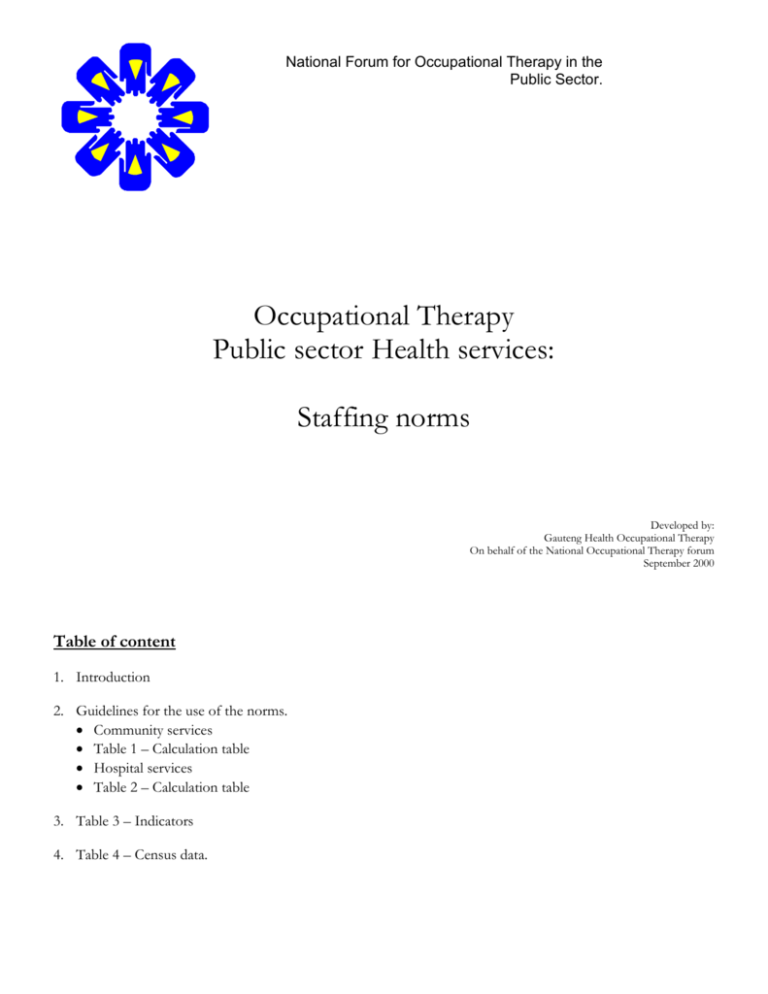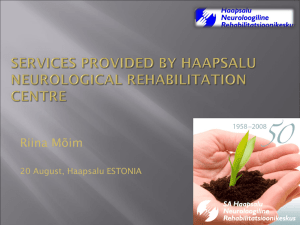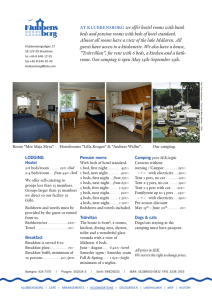Staff Norms
advertisement

National Forum for Occupational Therapy in the Public Sector. Occupational Therapy Public sector Health services: Staffing norms Developed by: Gauteng Health Occupational Therapy On behalf of the National Occupational Therapy forum September 2000 Table of content 1. Introduction 2. Guidelines for the use of the norms. Community services Table 1 – Calculation table Hospital services Table 2 – Calculation table 3. Table 3 – Indicators 4. Table 4 – Census data. Introduction The need has existed for many years to develop minimum staffing norms for Occupational Therapy in provincial health services. The National Occupational Therapy forum tasked Gauteng Health Occupational Therapy to develop basic staffing norms. Contributions from other provinces were included in this document. Financial constraints were considered during this process. When using this document, it is important to take cognisance of the following: It must at all time reflect trends and policies in Health care. Occupational Therapy is a dynamic profession and staffing norms can not remain static. Staffing norms have to reflect specific developments in the profession. This implies that this document should be regularly reviewed, changed and updated. Some flexibility should be allowed for to compensate for subtle differences between provinces and institutions. Minimum staffing levels for a comprehensive Occupational Therapy service in a specific area are reflected here. This implies that a comprehensive service can not be maintained in the event of staff losses and might run the risk of being terminated. This guideline should be used in consultation with health authorities for posts. Two sets of staffing norms have been developed. One set refers to hospital services and the second set to community services. It is foreseen that further refinement of this document should take place during a second phase i.e. Specific ratios for the different Medical disciplines in each of the three levels. Detailed ratios for psychiatry have already been developed by the Western Cape Occupational Therapists. Ongoing contributions to the document will be appreciated. Guide for the use of this document Users to familiarise themselves with the indicators and their application. See table 3 Obtain figures as required by indicators (For the benefit of the user critical figures from the 1996 census are included.) See Table 4. The following tables have been included to assist you in calculating the staff numbers for your province and/or hospital. Community services Calculations of community services: 1. Complete data in Table 1 as obtained in census. 2. Calculate Occupational Therapy staff numbers according to ratio and census data. 3. Calculate Occupational Therapy Assistant staff numbers according to the indicated ratio of Occupational Therapist to Occupational Therapy Assistant. 4. Calculate Assistant Director for each Health region. Table 1. Staff & Ratio User population in province Percentage unemployed Square kilometers Province specific data O.T. Ratio to data 1: 100 000 1 : 10 % 1: 15 000 2 to 1 2 to 1 1 to 1 O.T.A. Ratio to O.T A.D. Ratio 1: Region TOTAL Calculations of hospital services. Hospital services 1. Complete figures as indicated for a specific hospital 2. Calculate Occupational Therapy staff numbers according to data and ratio. 5. Calculate Occupational Therapy Assistant staff numbers according to indicated Occupational Therapist to Occupational Therapy Assistant ratio. 3. Calculate Assistant Director as indicated by ratio. (Hospitals with less than 15 staff members in total will not qualify for an Assistant Director’s post. Table 2. Staff & Ratio Bed number Level 1 Level 2 Level 3 Spinal Psych unit Burns Beds Work unit Hand unit Total Chronic Acute O.T. Ratio to numbers 1: 300 1: 120 1: 120 1: 15 1: 60 1: 30 1: 10 1: 6 1 : 15 1: 1 1:20 1:50 O.T.A. Ratio to O.T 0.5: 1 0.5 : 1 0.5: 1 1 to 1 2:1 0.5: 1 A.D. Ratio TOTAL 1:15 per hosp Indicators Table 3 Indicator User population in province Percentage unemployment Square kilometers Bed Number Level 1 Bed Number Level 2 Bed Number Level 3 Spinal/ Rehab Unit Psych unit – chronic Psych unit – acute Burns Beds Work unit Hand unit Explanation This figure is obtained from the census. The user population is approximately 75% of the actual population This figure is obtained from the census This figure is obtained from the census Level 1 bed refers to basic medical care beds. These beds may be in a district/regional or in an academic hospital Level 2 bed refers to patient in the sub acute phase, who is medically stable. These beds may be in a district/regional or in an academic hospital Level 3 bed refers to acute medical care beds. These beds may be in a regional or in an academic hospital Spinal/Rehab beds refer to specific beds allocated for spinal and rehab. These beds may be in a district/regional or in an academic hospital Psych - chronic beds refer to specific beds allocated for long term psych patients, these beds may be in a district/regional/special or in an academic hospital Psych - acute beds refer to specific beds allocated for short-term psych patients. These beds may be in a district/regional/special or in an academic hospital Burns beds refer to specific beds allocated for burns patients. These beds may be in a regional or in an academic hospital The work unit number is allocated by averaging the monthly head counts. The hand unit number is allocated by averaging the monthly head counts. Census data – 1996. Table 4 Province Population % Unemployment E Cape Northern Province KZN North West Mpumalanga Free State Northern Cape Gauteng Western Cape Total 6 302 525 4 929 368 8 417 021 3 354 825 2 800 711 2 633 504 840 321 7 348 423 3 956 875 40 583 573 48,5% 46% 39,1 % 37,9 % 32,9 % 30% 28,5 % 28,2 % 17,9 % 33,9 % Square kilometers 169580 123910 92100 116320 79490 129480 361830 17010 129370 1219090





